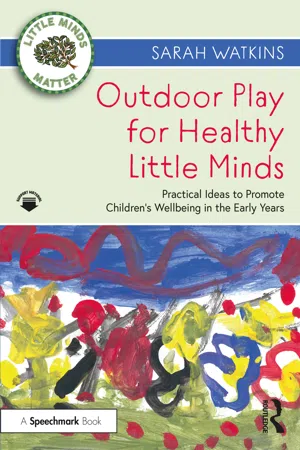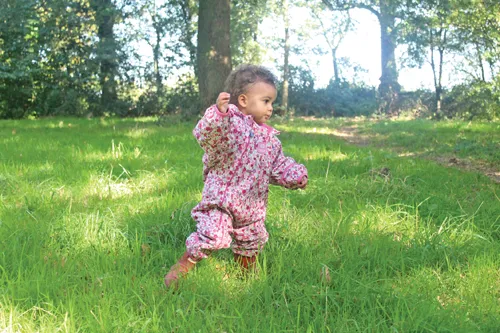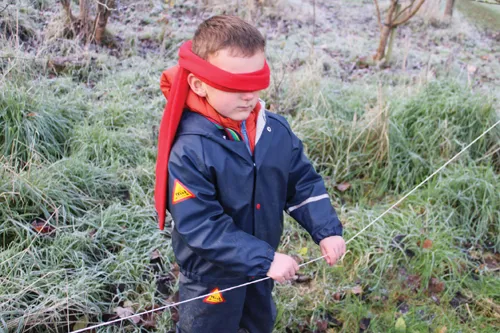
Outdoor Play for Healthy Little Minds
Practical Ideas to Promote Children's Wellbeing in the Early Years
- 160 pages
- English
- ePUB (mobile friendly)
- Available on iOS & Android
Outdoor Play for Healthy Little Minds
Practical Ideas to Promote Children's Wellbeing in the Early Years
About This Book
This essential resource is designed to help busy early years practitioners to support the mental health of young children through outdoor play.
Promoting social and emotional wellbeing in childhood has never been more important, and outdoor play is a crucial tool to build resilience, develop healthy relationships, and boost self-esteem. Using relatable case studies that demonstrate achievable change, the book is full of practical advice and strategies for exploring nature in both natural and man-made landscapes, and includes guidance on how to co-create inviting play spheres with children.
Each chapter provides:
-
- Adaptable and cost-effective activities designed to help children feel more confident and connected to the world around them.
-
- Case studies and reflective opportunities to prompt practitioners to consider and develop their own practice.
-
- An accessible and engaging format with links to theorists, risk assessment, and individual schemas.
Outdoor play allows young children to explore who they are and what they can do. It supports them as they learn to think critically, take risks, and form a true sense of belonging with their peers and with the wider community. This is an indispensable resource for practising and trainee early years practitioners, Reception teachers, and childminders as they facilitate outdoor play in their early years setting.
Frequently asked questions
Information
1 Green is good
“Inside is stuffy. Outside there are no limits. You can just run free.” Emily

Introduction
“What would our lives be like if our days and nights were as immersed in nature as they are in technology?” (Richard Louv, 2012)

Healthy mind…
“Being outside lets you relax your brain.” Emily

Attention restoration theory
- Clearer head or concentration. At this stage, we let go of thoughts, worries, and concerns that are demanding our attention.
- Mental fatigue recovery. We can feel drained and mentally exhausted by activities that require focused and directed attention, and this stage allows directed attention to recover and to be restored to normal levels.
- Soft fascination or interest. A low-stimulation activity enables us to be gently distracted and engaged, reducing the internal noise and providing a quiet internal space to relax.
- Reflection and restoration. We’re able to relax, restore our attention, and focus on what really matters by spending a longer period of time in an appropriate natural environment (Kaplan and Kaplan, 1989).


Mindfulness outdoors

- String walk: tie a length of string between two trees (or objects). If possible, the area below the string should include different gradients and terrain. Give each child a blindfold and ask them to follow a piece of string to its conclusion. The children get sensory feedback from the string, acoustic sounds, the tree bark, long grasses, and low dips in the ground.
- Cloud watching: this is a great way to distract the mind from stresses and worries. Once you draw children’s attention to it, they will see that a cloudy sky often changes very rapidly. It’s particularly satisfying to watch clouds on the horizon in autumn or winter – they can look like ever-changing cities. Gavin Pretor-Pinney, founder of the Cloud Appreciation Society, points out that we hardly even notice clouds unless they obstruct the sun. The bad press that clouds get is totally unfair. Clouds are in fact the most diverse, evocative, poetic aspect of nature. They remind us that we are creatures that inhabit this ocean of air. We don’t live beneath the sky; we live within it. The digital world conspires to make us feel perpetually busy. Slowing down and being in the present, not thinking about what you’ve got to do, what you should have done, just being here, letting your imagination lift from the everyday concerns. It’s good for you.(Pretor-Pinney, 2013)
- Sit spot: this was an activity that I was shown on my Forest School course. Children and adults find their own special spot and sit there quietly. Very young children may only be able to do this for a few seconds at first, but you can gradually build up the time. Encourage children to...
Table of contents
- Cover
- Endorsements
- Half-Title
- Series
- Title
- Copyright
- Contents
- Acknowledgements
- Foreword
- Introduction
- 1 Green is good
- 2 Beneficial spaces
- 3 The wellbeing laboratory
- 4 Dare to play
- 5 Relationships matter: The role of the adult
- 6 Honesty and love
- Closing remarks
- Index